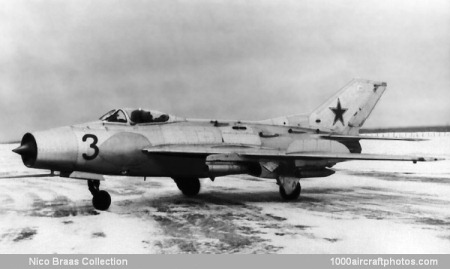01/31/2013. In its definitive form the ultimate extrapolation of the basic MiG-19 design, the SM-12 evolved, by a process of incremental modification, as a mixed-power point defense interceptor. As the MiG-19S was phased into service with the Soviet AF mid-1956, the MiG design bureau was continuing the refinement of the Izdeliya SM twin-engined fighter initiated in 1951 with the SM-1 (also known as I-340).
The SM-12 first saw life as an exercise in drag reduction by means of new air intake configurations, and the first of three prototypes, the SM-12/1, was essentially a MiG-19S with an extended and straight-tapered nose with sharp-lipped orifice and a pointed, two-position shock cone on the intake splitter.
The third prototype, the pictured SM-12/3, differed from its two predecessors primarily in discarding the paired AM-9B (RD-9B) engines for two R3-26 turbojets developed from the earlier power plant by V.N. Sorokin. These each offered an afterburning thrust of 7,936 lb (3,600 kg), enabling the SM-12/3 (site files) to attain speeds ranging between 888 mph, 1,430 kmh) at sea level, and 1,199 mph, 1930 kmh) at 39,370 ft (12000 m), and an altitude of between 57,415 and 59,055 ft (17,500 and 18,000 m) during its test program.
This outstanding performance prompted further development with a view to production as a point defense interceptor. Similarly powered by R3-26 engines and embodying major nose redesign with a larger orifice permitting introduction of a substantial two-position conical center body for a TsD-30 radar, a fifth prototype was completed as the SM-12PM (site files). Discarding the wing root NR-30 cannon of preceding prototypes, the SM-12PM was armed with two K-5M (RS-2U) beam-riding missiles and entered flight test in 1957.
This was joined at the end of 1958 by yet another (sixth) prototype, the
SM-12PMU. This had R3M-26 turbojets uprated to 8,377 lb (3,800 kg) st with afterburning and augmented by an U-19D accelerator which took the form of a permanent ventral pack containing an RU-013 rocket motor and its propellant tanks. Developed by D.D. Sevruk, the RU-013 delivered 6,614 lb (3,000 kg) of thrust. With the aid of this racket motor, the SM-12PMU attained an altitude of 78,740 ft (24,000 m) and a speed of Mach 1.69, but the decision had been taken meanwhile to manufacture the Ye-7 in series as the MiG-21P and further development of the SM-12 series was therefore discontinued.
